Measuring B2B Social Media ROI: Essential Tips For Marketers
Discover a series of powerful tips that will help marketers better understand and report on their b2b social media ROI.


Social media has become a necessary part of every B2C and B2B marketing strategy, with 95% of B2B marketers including it in their plans.
Yet, 83% of marketers struggle to measure social media ROI, primarily because identifying the right metrics can be challenging.
In this article, we’ll explore practical strategies to help you effectively measure the ROI of social media for your B2B marketing efforts.
What is ROI in B2B social media?
Every marketing campaign has one goal in common: getting as much return on investment (ROI) as possible. In the context of social media ROI for B2B, it refers to the measurable value a business gains from its social media efforts compared to the resources (time, money, and effort) invested.
For B2B companies, social media ROI isn’t just about likes, shares, or impressions—it’s about achieving outcomes that align with business objectives. This could include generating high-quality leads, increasing website traffic, enhancing brand awareness among decision-makers, or driving conversions that directly impact revenue.
Calculating ROI from social media marketing for B2B typically involves analyzing the relationship between the cost of social media campaigns and the financial or strategic gains they deliver.
While the ROI formula- (Revenue Gained - Cost of Investment) / Cost of Investment—is simple, the challenge lies in accurately attributing business outcomes to social media activities.
What’s the relevance of social media ROI in B2B social media marketing?
Understanding the ROI of B2B social media marketing is important due to the unique characteristics of B2B sales.
Unlike straightforward transactions, B2B involves longer sales cycles, complex decision-making processes, and multiple touchpoints. These dynamics make it critical to evaluate how effectively social media efforts contribute to business goals.
In the social media sphere, B2B strategies are designed to address the needs of various stakeholders, such as executives and technical experts. Social media platforms, especially LinkedIn and X, play a pivotal role in building awareness, fostering trust, and nurturing leads across this multi-step journey.
Whether it’s through educational content, targeted ads, or thought leadership posts, marketing through social media efforts helps guide prospects through each stage of the funnel.
Measuring the ROI of B2B social media marketing provides valuable social media insights into which campaigns drive the most impact. It helps identify the most effective touchpoints, the content that resonates with the audience, and the platforms that deliver results.
Tracking ROI also ensures that time and budget are spent wisely, allowing businesses to refine their strategies for greater efficiency and long-term success.
Focusing on the ROI of B2B social media marketing allows companies to optimize their efforts to not only generate leads but also build lasting relationships and drive meaningful results in a competitive social media market.
What is a good ROI in B2B social media?
LinkedIn is undeniably the go-to platform for B2B lead generation, contributing a remarkable 97% of all B2B leads. In contrast, X accounts for 13%, and Facebook trails at just 7%. These figures make it clear why LinkedIn should be a top priority for any B2B social media strategy.
Generating four out of every five B2B leads, LinkedIn’s impact surpasses all other platforms combined, highlighting its unmatched value in B2B marketing efforts.
But what exactly constitutes a “good” ROI in B2B social media? While the answer can vary based on the platform, industry, and campaign goals, here are some general benchmarks and considerations.
General benchmarks
A 3:1 ROI (earning $3 for every $1 spent) is widely considered a solid return for B2B social media campaigns. This means that for every dollar you invest in social media, you should aim to generate three dollars in revenue. Achieving this benchmark indicates that your social media efforts are contributing effectively to your business objectives.
Platform-specific expectations
- LinkedIn: Given its dominance in B2B lead generation, LinkedIn often delivers high-quality leads that convert reliably, albeit at a higher cost per lead. A well-optimized LinkedIn campaign can yield an ROI starting at 3:1, but it can go significantly higher for businesses targeting niche markets or decision-makers.
- Facebook/Instagram:While these platforms are cost-effective for lead generation, they lack the precise targeting capabilities LinkedIn offers for B2B audiences. As a result, an ROI closer to 2:1 is considered reasonable, especially for campaigns focused on brand awareness or top-of-funnel activities.
- Twitter/X:
This platform is typically more effective for building thought leadership and fostering engagement rather than direct lead generation. Consequently, ROI here is often measured in non-monetary terms such as impressions, follower growth, and engagement metrics.
Longer sales cycles in B2B
B2B marketing often involves longer sales cycles, with multiple stakeholders influencing the decision-making process. As a result, social media campaigns may not lead to immediate revenue.
In these cases, focusing on pipeline value—the potential revenue from leads generated—is essential for calculating ROI. This approach provides a clearer understanding of how social media efforts contribute to long-term business goals.
Other factors influencing ROI in B2B social media
Industry
- High-tech, SaaS, and enterprise solutions often achieve higher ROI due to larger deal sizes and recurring revenue models.
- Businesses offering commodities or lower-margin services may experience more modest ROI benchmarks.
Business maturity
- Established companies with refined processes and clear brand recognition often see higher ROI.
- Startups or businesses in their early stages may face lower ROI initially as they experiment with strategies and build trust with their target audience.
How to measure ROI from social media for B2B companies?
Measuring ROI in B2B social media is essential for understanding the effectiveness of your campaigns and making data-driven decisions. Below are detailed steps to help B2B companies assess and optimize their social media success.
#1. Define your ROI goals and metrics
Before measuring ROI, clearly define what you aim to achieve with your social media efforts. Goals should align with your overall business objectives and might include:
Lead generation
Focus on metrics like form submissions, demo requests, or webinar sign-ups. For example, if your goal is to generate 50 qualified leads per month, track how many of those leads come directly from your LinkedIn ads or promoted posts.
Brand awareness
Use metrics such as impressions, reach, and engagement to evaluate visibility. Social media analytics tools like Socialinsider can help track these metrics effectively.
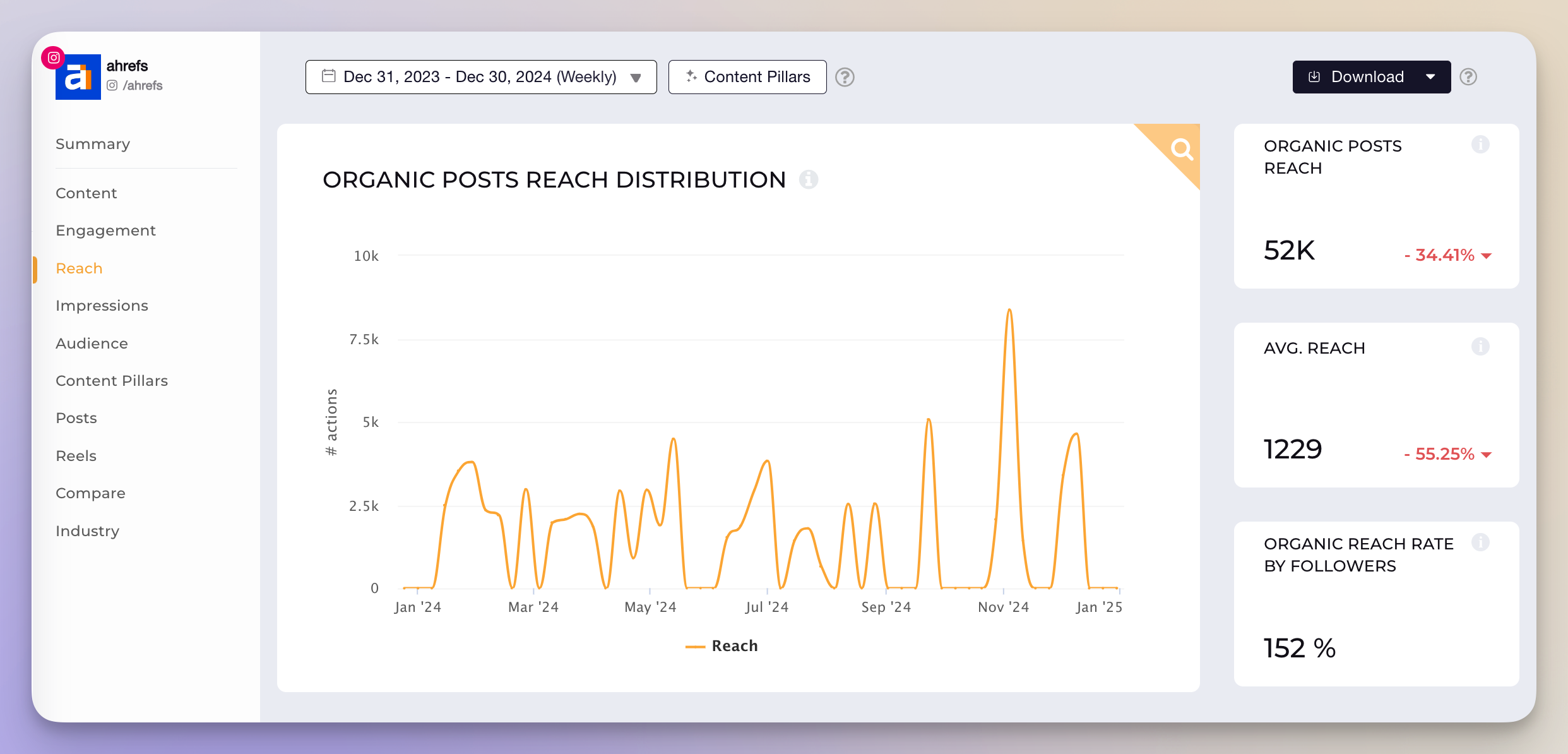
Customer retention
Track repeat interactions, account expansions, and referrals. For example, monitoring social media comments or messages from existing customers can provide insights into retention and satisfaction.
Key metrics to measure include:
- Conversion rates (e.g., leads to MQLs/SQLs) to determine the effectiveness of your funnel.
- Cost per lead (CPL) to evaluate efficiency.
- Customer lifetime value (CLV) to measure the long-term impact of social media on revenue.
- Social media engagement rates (e.g., comments, shares, video views) to assess how your audience interacts with your content.
Socialinsider can help B2B marketers track engagement metrics like video views, comments, and shares, making it easier to evaluate the performance of your campaigns and optimize for higher interaction rates.
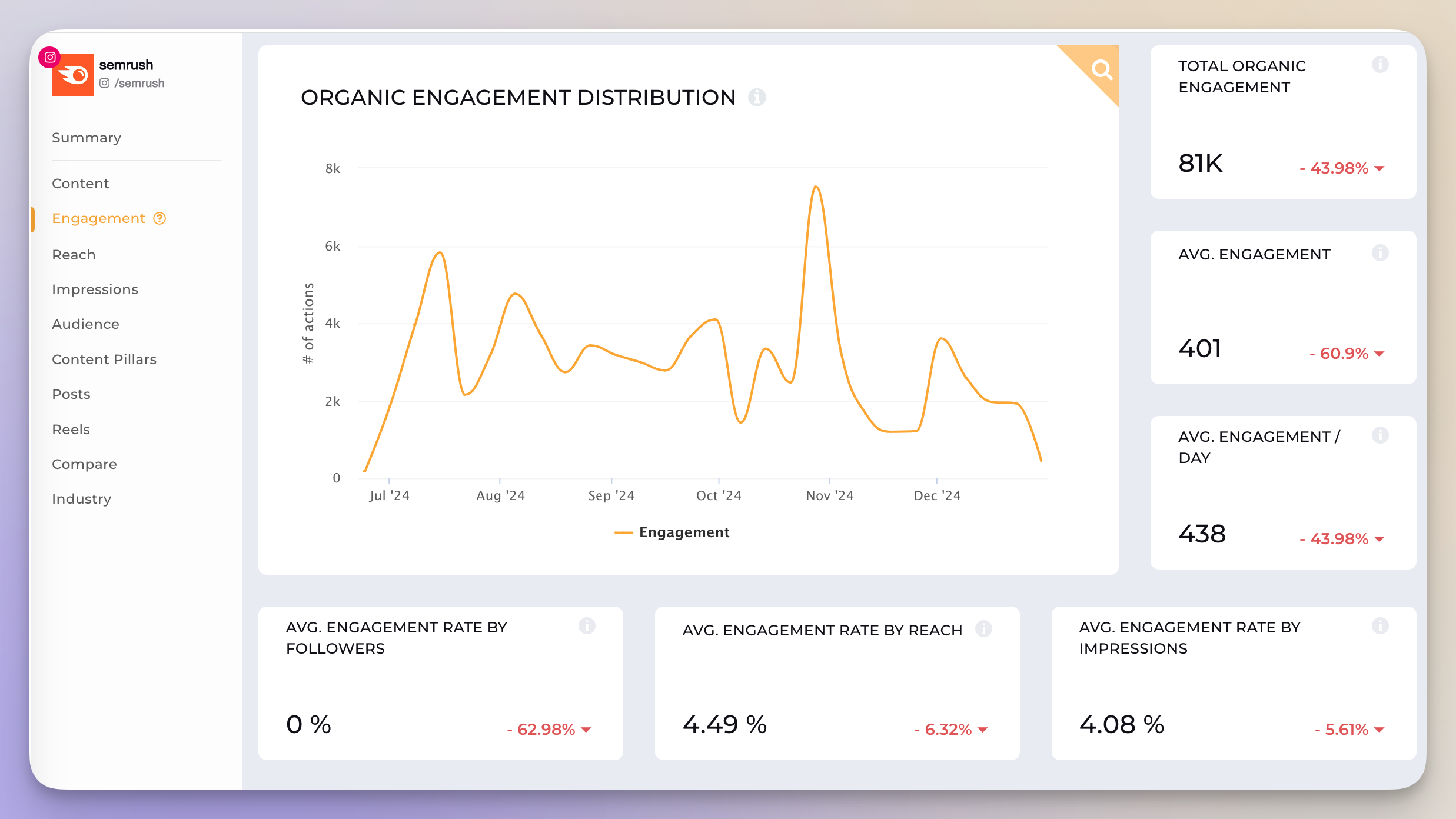
#2. Track social media costs
To calculate B2B social media ROI accurately, you must account for every cost associated with your social media activities. These costs typically fall into the following categories:
Ad spend
This includes the money spent on promoting posts, running LinkedIn ads, or launching sponsored content campaigns. For example, if you’re running a $10,000 campaign to promote a whitepaper on LinkedIn, this cost should be factored into your ROI calculation.
Tools and platforms
Tools like Socialinsider, Google Analytics, and scheduling platforms (e.g., Planable) have subscription costs that need to be accounted for. Socialinsider, for instance, can help you track engagement rates, impressions, and campaign performance.
Manpower
Include the time and salaries of team members involved in social media management. For example, if your team spends 20 hours a week on social media content creation and strategy, multiply those hours by their hourly rate.
Creative costs
These include graphic design, video production, and content writing expenses. For instance, hiring a freelance designer to create custom LinkedIn infographics or producing a video for a social media campaign involves direct costs that contribute to your overall investment.
#3. Set up tracking systems
To measure ROI in B2B social media effectively, you need systems that capture data and connect it to your social media goals. Here’s how to set up the infrastructure for tracking your social media campaigns:
Google Analytics
This platform allows you to track social media traffic and conversions originating from social media. For example, if a visitor from LinkedIn fills out a contact form on your website, Google Analytics can attribute that lead to your LinkedIn campaign.
UTM parameters
Adding UTM tags to URLs helps trace leads back to specific social media posts or campaigns. For instance, you can differentiate between traffic driven by an organic LinkedIn post versus a paid ad by analyzing UTM-tagged links.
CRM tools
Integrate social media data into your CRM systems, such as Salesforce or HubSpot. This enables you to connect social media interactions to sales outcomes. For example, you can track how a LinkedIn lead progresses from initial contact to a closed deal.
#4. Attribute value to social media marketing activities for B2B
Attributing value to social media activities can be challenging, especially in B2B where multiple touchpoints are involved. Here’s how you can approach attribution:
Direct attribution
Direct attribution measures conversions that happen as a result of a single click or interaction. For example, tracking how many people clicked on your LinkedIn ad and signed up for a webinar.
Assisted attribution
Social media often serves as a touchpoint in the buyer’s journey rather than the final step. For instance, a prospect might engage with your thought leadership content on LinkedIn before being contacted by sales. Assisted attribution ensures that these earlier interactions are recognized.
Custom attribution models
Custom models assign weight to different touchpoints in the sales funnel. For example, if a lead interacts with your LinkedIn ad, downloads a whitepaper, and later attends a sales demo, you can allocate percentages of the conversion value to each activity.
#5. Calculate the B2B social media ROI
Standard ROI formula
ROI = [(Revenue Generated - Total Costs) / Total Costs] × 100
Example:
- Revenue generated: $50,000
- Total costs: $10,000
- ROI = [(50,000 − 10,000) / 10,000] × 100 = 400%
ROI for lead generation
- Cost Per Lead (CPL): Divide the total social media costs by the number of leads generated. For example, if you spend $5,000 and generate 100 leads, your CPL is $50.
- Conversion Rate: Calculate the percentage of social media leads that become paying customers. If 10 out of 100 leads convert, your conversion rate is 10%.
ROI for revenue generation
- Attributed Revenue: Use CRM data to track revenue directly influenced by social media. For instance, if $100,000 in deals can be traced back to LinkedIn campaigns, that amount contributes to your ROI.
- Customer Lifetime Value (CLV): Multiply the average revenue per customer by their retention rate to better understand the long-term impact of social media.
ROI for brand awareness or engagement
To effectively measure the ROI of influencer collaborations, it's important to track key metrics like impressions, reach, and engagement rates. These metrics help estimate the influencer's contribution to qualified leads or conversions.
To make this process easier, tools like Socialinsider can be used to analyze and track data from influencer campaigns.
For example, if you’re looking to measure the impact of a collaboration, you can track impressions, reach, and engagement rates step by step using Socialinsider. This will provide a clearer picture of how the influencer’s efforts translate into measurable results for your business.
Here’s how you can do it step by step using Socialinsider:
Step 1: Add influencers to your Socialinsider dashboard
Look at the influencers involved in your campaign or collaboration, by adding their profile to Socialinsider. This allows you to monitor their posting activity and analyze the performance of their content related to your campaigns.
In the example below, we’ll analyze a partnership between Semrush and Pretty Little Marketer.
Step 2: Search for specific campaigns or brand partnerships
After adding the account, use Socialinsider’s search feature to filter posts by campaign or brand partnership.
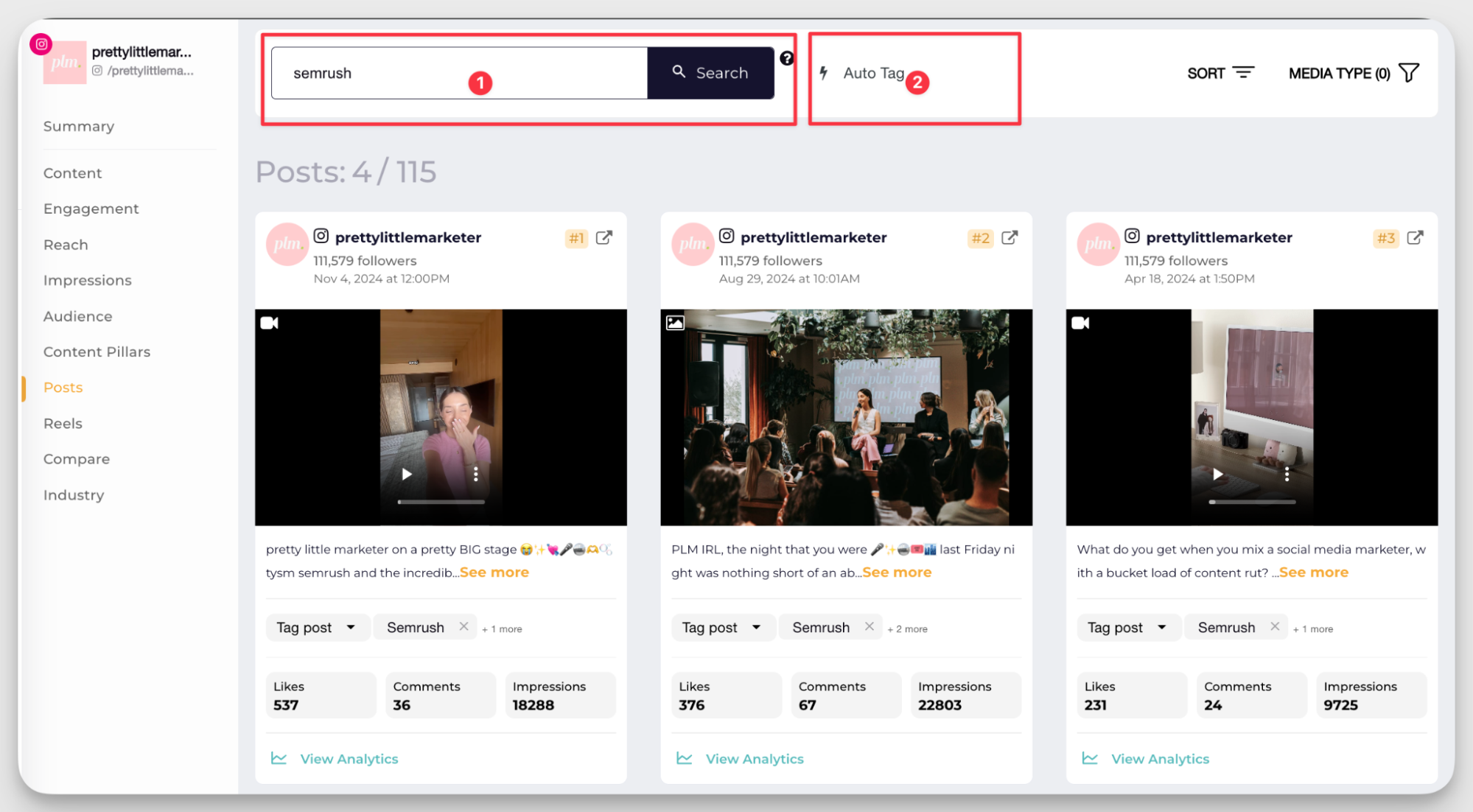
Step 3: Create a manual content pillar
Use the auto-tagging feature in Socialinsider to set up content pillars. This helps organize the data for easy tracking and comparison.
Step 4: Tag posts for the content pillar
Once your content pillar is set up, tag posts that fall under this category.
For the example mentioned, we tagged all the posts created by Pretty Little Marketer that mentioned Semrush.
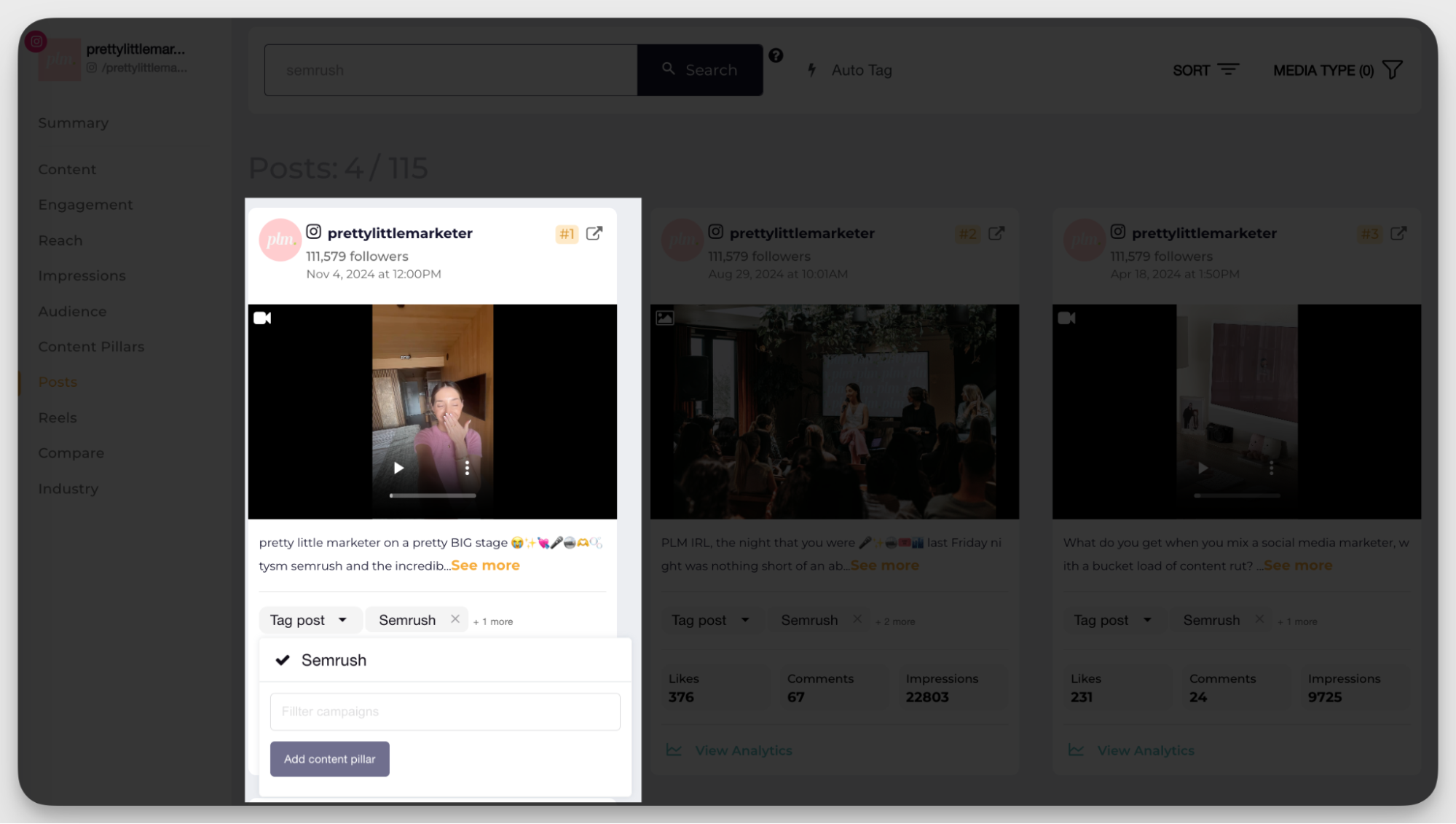
Step 5: Analyze metrics for engagement, reach, and impressions
After tagging, use the dashboard to pull detailed analytics on:
- Engagement Rates: Measure likes, comments, shares, and clicks to assess audience interaction.
- Reach: Track the number of unique users who viewed the influencer’s content.
- Impressions: Monitor how many times the content was displayed, including multiple views by the same users.
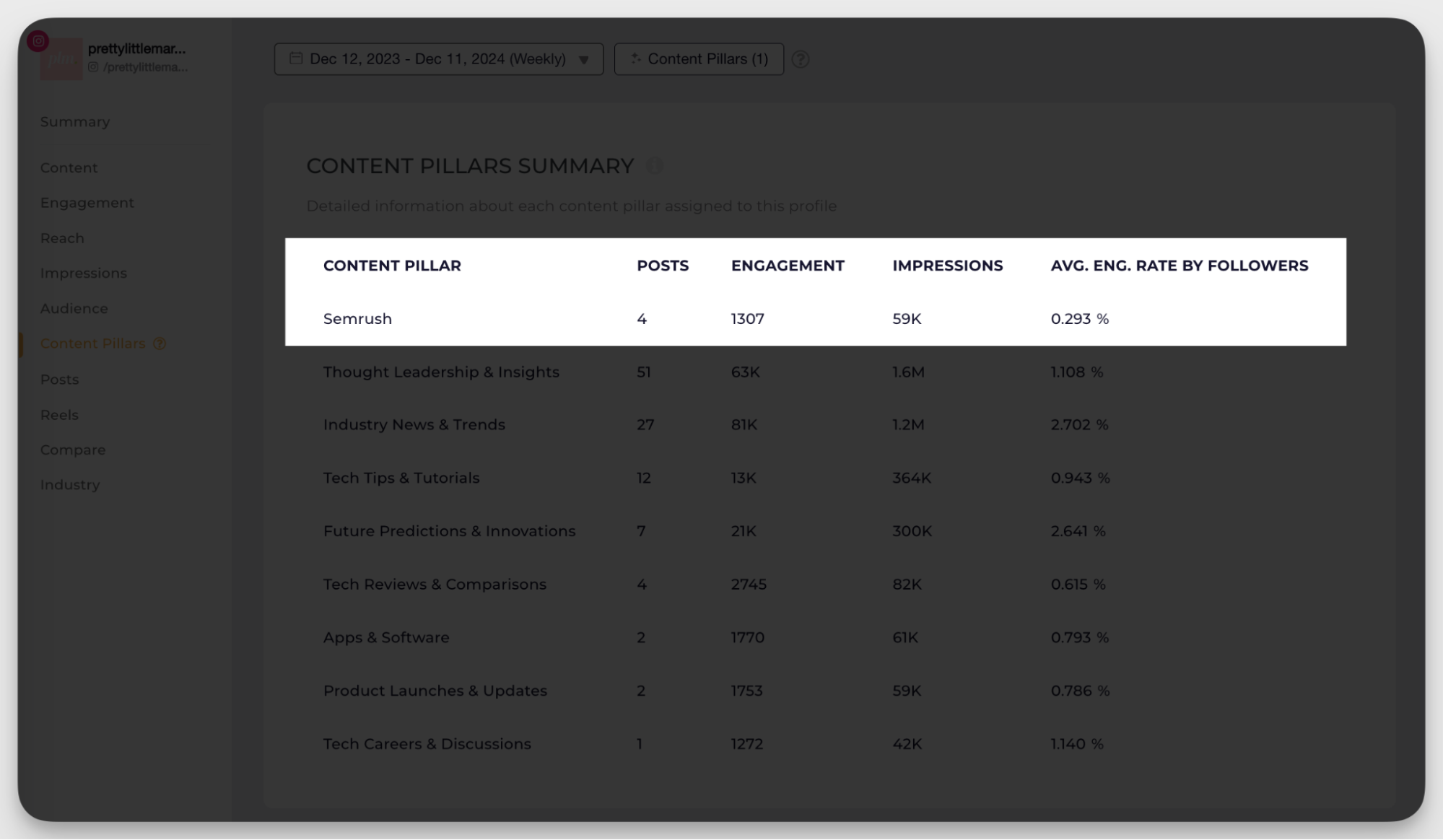
#6. Tie social efforts to revenue
For B2B companies, social media is more than just a tool for engagement; it’s a critical driver of business outcomes.
Tying social media efforts directly to revenue ensures you’re not only measuring the effectiveness of your campaigns but also demonstrating their impact on the bottom line.
Here’s how you can link your social media efforts to revenue using key metrics and strategies.
Measure lead quality
Not all leads generated through social media are created equal. In B2B marketing, the focus should be on high-quality leads that are more likely to convert into customers.
Here’s how you can measure lead quality from your social efforts:
- Track conversion rates: Monitor the percentage of leads generated through social media that progress through the sales funnel, such as moving from marketing-qualified leads (MQLs) to sales-qualified leads (SQLs). For example, if 100 LinkedIn leads were generated and 30 advanced to SQLs, your conversion rate is 30%.
- Assess lead fit: Use tools like LinkedIn Campaign Manager to analyze the job titles, industries, or company sizes of your social leads. High-quality leads should align with your ideal customer profile (ICP).
Focusing on lead quality ensures your social media efforts contribute to the sales pipeline, ultimately impacting revenue.
Quantify pipeline influence
B2B sales often involve long cycles and multiple touchpoints, making it essential to track how social media influences the pipeline.
Social media touchpoints can range from initial interactions, such as clicking a LinkedIn ad, to ongoing engagement with thought leadership content.
Here’s how to quantify pipeline influence:
- Track touchpoints: Use CRM tools like Salesforce or HubSpot to map social media touchpoints along the buyer’s journey. For example, a prospect might click on a Twitter post, download a whitepaper, and attend a webinar before closing a deal. Each of these interactions represents social media’s influence on the pipeline.
- Assign monetary value: Quantify the value of deals influenced by social media. For instance, if a $50,000 deal involved three social touchpoints, you can attribute a portion of the revenue to social media efforts.
- Use attribution models: Employ multi-touch or custom attribution models to assign weight to social interactions. For example, if a LinkedIn ad was the first point of contact, it might be given a higher percentage of the attributed revenue compared to subsequent interactions.
Tracking pipeline influence allows you to showcase how social media supports revenue generation, even if it’s not the final conversion channel.
Leverage account-based marketing (ABM)
Account-based marketing (ABM) is a powerful strategy for B2B companies targeting specific accounts. Social media plays a crucial role in engaging these accounts and moving them closer to conversion.
Here’s how to tie ABM efforts to revenue:
- Track Engagement by Account: Use platforms like LinkedIn to monitor interactions with targeted accounts. For example, track how many individuals from a specific account engage with your posts, ads, or sponsored content.
- Measure Content Performance: Evaluate the performance of social content aimed at specific accounts. For instance, measure how often decision-makers from your target accounts engage with thought leadership articles or case studies shared on social platforms.
- Link Engagement to Outcomes: Connect social media engagement with pipeline movement or deal progression. For example, if social engagement with an account leads to a product demo or proposal, attribute that activity to your ABM strategy.
Tying social media efforts to revenue for B2B companies involves focusing on lead quality, quantifying pipeline influence, and leveraging ABM strategies.
Integrating social media data with tools like CRMs and attribution models can help you demonstrate the tangible impact of your social campaigns on business outcomes and justify continued investment in this critical marketing channel.
#7. Test and optimize
To maximize B2B social media marketing ROI, continuous testing and optimization are crucial.
Regularly evaluating the performance of your campaigns helps you identify what works, refine your approach, and achieve better results over time.
Here’s how you can test and optimize your social media strategy to ensure you’re making the most of your efforts.
Compare organic vs. paid campaigns
Understanding the effectiveness of your organic vs. paid social media efforts is a vital part of improving ROI. Each serves a unique purpose in your overall strategy:
- Organic campaigns: Track engagement metrics like social media reach, impressions, and interaction rates to evaluate how well your content resonates with your audience. For example, if a LinkedIn post consistently drives high engagement, it may indicate that the topic or format appeals to your target audience.
- Paid campaigns: Assess metrics like cost per lead (CPL), click-through rates (CTR), and conversion rates to measure the return on your advertising spend. For instance, a LinkedIn ad targeting decision-makers with a free webinar sign-up offer might outperform a broader campaign, leading to better CPL and higher-quality leads.
Comparing these two approaches will help you determine where to focus your resources.
For example, if paid campaigns consistently deliver a higher ROI than organic efforts, you might allocate more budget to advertising while using organic content for brand awareness and relationship building.
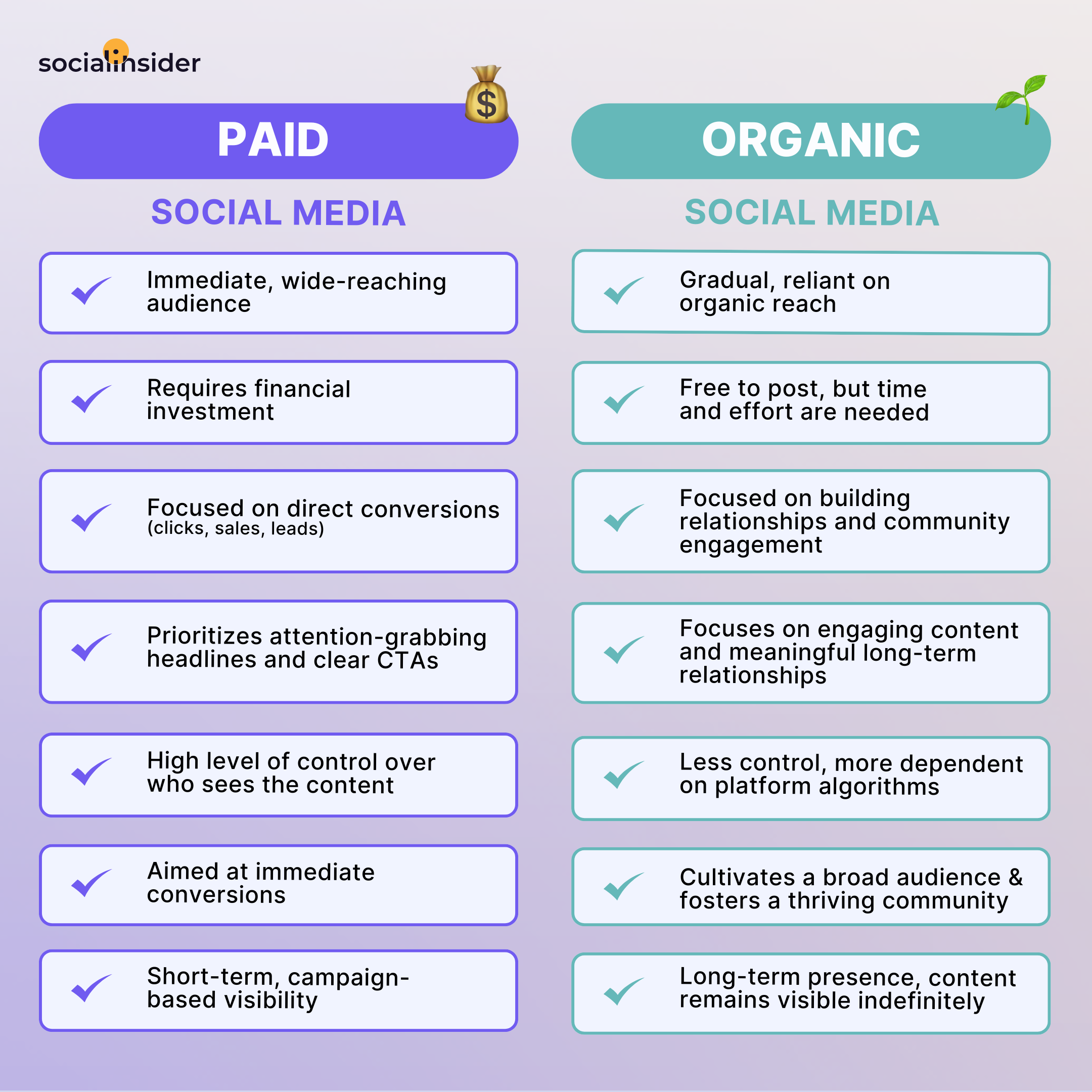
A/B test creatives, messaging, and CTAs
A/B testing is a powerful tool for improving campaign performance and increasing ROI. By testing variations of your content, you can identify what resonates best with your audience.
Here are some elements to test:
- Creatives: Experiment with different visuals, such as images, videos, or infographics. For example, test whether a product demo video generates more engagement than a static image post.
- Messaging: Compare different headlines, tone, or value propositions. For instance, test whether “Save time with our automation tools” performs better than “Streamline your operations with ease.”
- CTAs (Calls-to-Action): Try variations of your CTAs, such as “Download the guide” vs. “Get the free eBook.” Measure which CTA drives more clicks or conversions.
Using tools like LinkedIn Campaign Manager, you can track the performance of each variation and determine the best combination for achieving your objectives.
Optimize your content strategy based on performance data
The key to improving ROI of social media marketing for B2B is leveraging performance data to refine your content strategy. Use insights from your campaigns to make data-driven decisions:
- Identify high-performing content: Analyze which types of posts generate the most engagement, clicks, or conversions. For example, if thought leadership articles consistently perform well, you might prioritize creating more of this content.
- Adjust posting schedules: Use data to determine when your target audience is most active on social media. For instance, LinkedIn engagement might peak during weekdays, while Twitter/X may perform better during events or announcements.
- Refine targeting: Review audience insights to ensure your social media campaigns are reaching the right people. For example, if your CPL is high, you might need to adjust your targeting to focus on smaller, more relevant audience segments.
Keep testing and iterating
Optimization is an ongoing process. Regularly evaluate the results of your tests and implement changes to improve outcomes.
For instance, if a particular ad campaign performs exceptionally well, consider scaling it to reach a larger audience or replicating the approach in other campaigns.
To effectively measure ROI for B2B social media marketing, it’s essential to view testing and optimization as continuous efforts.
By consistently analyzing data, experimenting with strategies, and refining your approach, you can ensure that your social media efforts deliver maximum impact and contribute meaningfully to your business goals.
#8. Report findings to stakeholders
To demonstrate the impact of your efforts and secure continued investment as a social media analyst, it’s essential to communicate the value of your social media campaigns to stakeholders.
A well-structured report showcasing business ROI and actionable insights will help stakeholders understand how your strategies contribute to broader business goals.
Here’s how to create and present an effective ROI report for B2B social media marketing.
Highlight revenue generated and pipeline influenced
Stakeholders want to see tangible results. Clearly outline the financial outcomes of your social media campaigns, focusing on metrics that directly tie your efforts to revenue and pipeline growth. Include:
- Revenue generated: Show the total revenue attributable to social media campaigns. For example, if a LinkedIn ad campaign generated $100,000 in sales, make this a focal point of your report.
- Pipeline influence: Break down the monetary value of deals influenced by social touchpoints. For instance, if a $50,000 deal included three interactions with your social posts, attribute a portion of this value to your campaigns.
Use charts and visuals to make this data more accessible. A graph illustrating the impact of social media on business, such as its contribution to the sales pipeline over time, can help stakeholders better understand its significance and value.
Include specific examples of successful campaigns
Showcase detailed examples of high-performing campaigns to highlight what’s working and why. This helps stakeholders connect the numbers to real-world outcomes. Include:
- Campaign objectives: Explain the goal of the campaign, such as lead generation, brand awareness, or account-based marketing.
- Performance metrics: Share key metrics like click-through rates (CTR), cost per lead (CPL), conversion rates, and customer lifetime value (CLV).
- Target audience: Highlight who the campaign targeted and how well it resonated. For example, “A LinkedIn campaign targeting IT decision-makers resulted in 30 SQLs and $25,000 in pipeline revenue.”
- Creative and messaging: Include visuals of the campaign’s creatives, such as ad designs or post screenshots, to illustrate how the strategy was executed.
This way, you not only build credibility but also inspire stakeholders with proven approaches.
Share insights and recommendations
Your report should go beyond social media metrics to offer meaningful analysis and actionable suggestions. Use the data you’ve collected to answer questions like:
- What worked well? For example, “Video ads on LinkedIn targeting operations managers had a 15% higher engagement rate compared to static image ads.”
- What needs improvement? Highlight underperforming areas, such as low engagement rates on certain platforms or high CPLs.
- What’s next? Provide recommendations based on your findings. For example, “Increase investment in thought leadership content on LinkedIn, as it drove the highest pipeline influence last quarter.”
Structure your report for clarity
To ensure your stakeholders can easily understand and act on your report, structure it logically:
- Executive summary: Begin with a brief overview of the report, summarizing key metrics and findings.
- Objectives: Clearly state the goals of your social media campaigns.
- Performance metrics: Present data on revenue generated, leads acquired, and pipeline influenced, supported by visuals like charts and graphs.
- Case studies: Share examples of successful campaigns, including their goals, strategies, and outcomes.
- Insights and recommendations: Conclude with your analysis and actionable next steps.
📌 Download your social media performance report template in an Excel format
📌 Download your social media analysis report template in a PowerPoint format
Use tools for tracking and reporting ROI
Leverage tools like Socialinsider, Google Analytics, and your CRM (e.g., Salesforce or HubSpot) to gather data and present it effectively. These tools help you calculate your ROI for B2B social media marketing and track key metrics like lead quality, conversion rates, and deal influence.
For example, use Google Analytics to show how much website traffic and conversions were driven by social media, and combine it with CRM data to attribute revenue to specific campaigns.
Socialinsider can further support your reporting by tracking metrics like impressions, engagement rates, and influencer performance.
Explain the broader business impact
Finally, tie your social media performance back to overall business goals. For example:
- Improved brand awareness: Highlight increases in reach or engagement that contributed to positioning your company as a thought leader.
- Lead generation efficiency: Show how social media campaigns delivered leads at a lower CPL compared to other channels.
- Sales team enablement: Demonstrate how social media influenced high-value deals, supporting the sales team’s efforts.
Final thoughts
Effectively measuring the ROI of social media marketing for B2B is no longer optional—it’s essential for staying competitive and justifying investments.
By aligning your social media efforts with business objectives, tracking meaningful metrics, and leveraging social media analytics tools, you can transform your campaigns into powerful drivers of revenue and brand growth.
In a B2B world marked by longer sales cycles and complex decision-making, your ability to demonstrate ROI through strategic social media marketing will not only validate your efforts but also position your brand as a trusted leader in your industry.
By leveraging the insights and methodologies, you can build a sustainable, results-driven social media strategy that delivers both immediate wins and long-term value.
FAQs on b2b social media ROI
What are the main challenges in proving social ROI for B2B marketing?
B2B marketers face social media challenges like long sales cycles, making it hard to see immediate results, and multi-touch attribution, where buyers engage across many channels. Intangible benefits like trust and awareness are difficult to quantify.
Tracking leads is complex as they often convert elsewhere. High costs on platforms like LinkedIn can skew ROI perceptions without considering lead quality. Additionally, changing algorithms can impact social media growth and performance, complicating efforts to measure social media marketing results for B2B effectively.
Analyze your competitors in seconds
Track & analyze your competitors and get top social media metrics and more!
You might also like
Improve your social media strategy with Socialinsider!
Use in-depth data to measure your social accounts’ performance, analyze competitors, and gain insights to improve your strategy.




